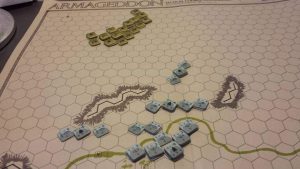
Da un vecchio post del 2017 dedicato alla serie Prestags SPI e uno dei wargame antesignani: “Armageddon”.
4. The Delta, ca. 1675 BCE
Historical background
Who: Egyptians and Hyksos
Where: Nile Delta
Result: Hyksos’ victory
Forces: unknown
Why it matters: The first use of chariots and composite bows
Board Wargame: Armageddon (SPI 1972) and Chariot (SPI 1975)
In 2010 radar imaging of Egypt’s Nile Delta revealed the outlines of a buried city, some 3,500 years old. Discovered in Tel-el-Daba in the northeastern Nile Delta in 1885, the ruins belong to the southern suburban quarters of Avaris, the capital of the Hyksos kings who formed Egypt’s 15th dynasty. Despite Senusret’s campaigns and other several minor conflicts until the end of the middle Kingdom, around 1675, Egypt enjoyed a period of internal peace and stability. Unfortunately, all good things end! In 1652 an invader coming from Asia attacked Egypt. The menace was called Hyksos, the Shepard-Kings. However, Hyksos is an Egyptian word meaning Foreign Lands Kings. They brought horses and chariots with them as well as light armor. They overwhelmed the Egyptian forces, less mobile and without armors. The Hyksos had no permanent homes, they did not practice agriculture. Everything they needed was from animals. They were constantly on the move searching for land where their animals could graze. They excelled at war and possess an advanced military technology. They used the composite bow, made of wood and horn. That allowed them to launch the arrows better than the Egyptians could do and they wore bronze body armor. For the first time the Egyptian could see the chariots running and fighting. The Hyksos’ chariots were made of light wood with a leather platform carrying two soldiers, the driver, and the fighting man. Two horses pulled the Hyksos chariots that had spoken wheels so they were light and fast. Well we can compare the appearance of the new chariot to a German tank. Think of a Tiger appearing on the battlefield! Now try to imagine what the Egyptians could do to stop the invaders. The chariot represented a new way of battling, the armies needed new tactics, an army composed of only infantry units could not prevail against such mobile forces. The same happens between the two world wars. It was clear at the end of the First World War that the tanks would have changed the tactics to fight in a near future.
The Hyksos conquered all the Lower Egypt and Upper Egypt. Only a small part of the Nile remained free and the Egyptians controlled only eight districts (nomes). It was the beginning of a long century of foreign domination that ended with Ahmose I. Although the Egyptians refused to admit it, Egypt profited by the Hyksos rule. Egypt stopped being isolationist and began to be involved with the rest of the civilized world.
Playing the battle
The scenario included in the game Armageddon (The Delta. SPI 1972) gives a precise idea about the forces on the battlefield. The Hyksos have many chariots supported by heavy units armed with axes. By dealing with the historical resources, there should be more units with composite bows, On the other side we find an Egyptian army made up of only infantry units and composite bows. The designers Stephen B. Patrick and John M. Young give a great superiority to the use of chariot in melee. On the combat table the presence of any chariot in the fighting gives 2 shifts of columns. The Hyksos army has about 1000 chariots to exploit on a complete plain terrain. A charge followed by the several Axe men don’t give any chance of winning to the Egyptian army. But a wargame has not to follow what happened in history. That’s the fun we find when we are playing. We can try to subvert the historical result. Winning with the Egyptian is a challenge. Three years later, in 1975, SPI produced another game like Armageddon, Chariot but there was an important change in the rules about the chariots. The shifting of the columns for units attacking embarked on chariots had been removed. The great mobility given by the chariots was still present, but the impact on the close combat was removed. The designer was the same but he justified his modification by stating that the chariot was a weapon that accelerated the strike power of missile weapon and rendered the embarking men less vulnerable to return fire.
The Delta scenario is a very interesting and challenging battle. One of the few games in the history of board wargaming to simulate that ancient and legendary battle. Kim Meints has played completely the battle and it’s interesting to report his analysis from the Consimworld site: “This scenario sees the Hyksos (Green) bringing fast horse-drawn chariots into play. Their objective here is the small oasis across the river. Noted that Green deploys and moves first in this scenario so they’re set forward in line, ready to charge. For the Egyptians (Blue) I decided to set-up forward on the slopes rather than hide out on the reverse. So, they’re ready to receive a chariot attack. Hoping that missile fire and slope advantages will blunt the attack. Unless the Hyksos break into two parts the Egyptians should be able to get a flanking maneuver on one end of their line. A small force is held back at the oasis should the Hyksos attempt to charge through the pass or out-flank to the west.”


